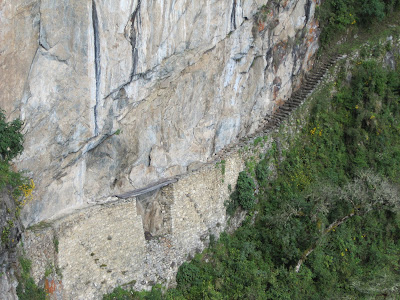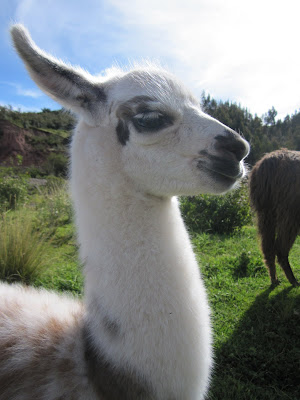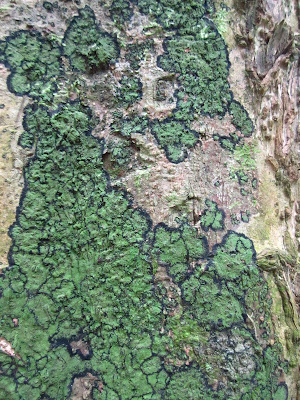After 'allowing' to acclimatise ourselves, we got in the train heading to Machu Picchu. Even though our train meant to start from Cusco, we had to take a bus for 2-3 hours and then from Ollantaytambo another 2 hours to reach Aguas Calientes, the closest village to the sanctuary. The en route landscape was fantastic. We left Cusco behind to climb up and then down to Aguas Calientes. The train went through gorges and rivers, on a slow ride with magnificent panoramic views from within the train. It was comfortable and the on board service was great! Even though it was packed with hordes of tourists, it was a nice experience, leaving the mind to travel back in time and feel you are indeed in a sacred place.
THE train route in the Andes
THE panoramic views
Last train to Machu Picchu
Machu Picchu, one of the -modern- seven wonders, it was daunting and mysterious. From Aguas Calientes (aka Macchu Picchu Pueblo), another bus took us up the hill on a twirly road. Walking towards the monument, I was slowly slowly getting breathless, unspeakable, not because of the altitude, this time was the views and the landscape itself. It was MAJESTIC! Urubamba river was flowing down below, and lush forested green sharp mountain peaks all around. Wayna Picchu, maybe the most photographed peak in the world, was standing there, high and mighty. In fact, someone can trek the peak in a steep 2-3 hours ascent, but they allow only 400 people per day (200 at 7am and another 200 at 10am). We arrived later than this and missed that opportunity. People we met on the road who done that said it was worth the climb, the views were amazing. Although, we walked to the Inca bridge. A pathway to/from Machu Picchu to other local places, ending up to a wooden bridge on a steep rock, a bridge which could be removed preventing people passing through. It was closed for aspiring trekkers but still we went pretty close. It was continuing to a small path on a massive steep rock, with hundred of meters free fall in case you step to the wrong place..
Machu Picchu is a perfect example of the Incas architecture and their fine masonry skills. The Incas were great engineers and empire builders. In July the 24th will celebrate its 100th anniversary since it was first discovered by Hiram Bingham, an archaeologist led by local shepherds who shown him the site. A city lost almost four centuries, never discovered by the spaniards or other conquerors in the region. The site itself is of course a Word Heritage site and the Peruvians do great work preserving it. On top of the capacity limit on the Inca trail (500 people per day inc porters and guides) discreet site staff were always there to remind us not to step onto stones that are not in the pre designed areas, the area was clean despite the thousands of tourists per day, and generally there was a sense of respect and order.
Many artefacts including several mummies, fine pottery, bones and utensils were transported in US in 1915 with the aim to study the items under the conditions that the ownership will reside with Peru and they will be returned in 1918. Bingham would have never imagined the items taken would create a major diplomatic issue between the two countries. The artefacts went to Yale University and almost hundred years later a dispute between the Peruvian government and Yale University is still ongoing.
Machu Picchu_The Black llama calling
Machu Picchu_Two floors settlement
Machu Picchu_Urubamba river
Machu Picchu_Fine masonry [the guy on the ladder played the Zorba
on his phone to Angelos!)
Machu Picchu_Wayna Picchu peak
Machu Picchu in 1911(pic courtesy of wikipedia:)
Machu Picchu_Memorial to 50 years since discovery
Machu Picchu_The Inka bridge
After a long day at the sanctuary, we trekked down to Aguas Calientes on another steep path ending at Urubamba river. We reached the village and sat to enjoy some food and a local delight.
Cusqueña_Local delight
Next day we decided to go out and about to the Sacred Valley. We met Manolis and Nefeli, chose a route, hired a taxi and off we go. First we visited Tambomachay, a ceremonial stone bath structure channelling spring water through fountains that still function today! Less touristy here but still we managed to meet a group from Greece and typically get embarrassed from our talks before realising they were speaking Greek too... On our walk to the nearby site we met those lovely llamas, they look relaxed and friendly and fluffy and I wanted to take one back home, if possible.
Sacred Valley_Tambomachay, or El Baño del Inca
Sacred Valley_We're just chilling...
Sacred Valley_...and happy to be photographed
Sacred Valley_Sacsayhuaman or otherwise Sexywoman(!)
After all the sightseeing and trains and buses and Cusco nightclubbing we got on the road on the way to the mighty jungle. An eleven hour bus ride, from the high altitudes to the Amazon green carpet. The trip was overnight so we didn't get the chance to see the views of the Amazon from above. The bus was great and they offered dinner too! We arrived in Puerto Maldonado early morning.
Palomino's bus food
The lake was simply a paradise on earth. A peaceful lake in the middle of a the jungle, home to many caimen and giant otters, the largest of the otter family, declared endangered. We took the gondola and paddle to the lake banks. The vegetation was such that you couldn't see the river banks. Trees were hanging from above to the top of the lake, birds were everywhere and ourselves paddling speechless to the beauty of our surroundings. The place was thriving of life! In the night, went out again and our guide managed to catch a little caiman to see it from close and photograph it.
Amazon_Lago Sandoval
Lago Sandoval_Young caiman
Lago Sandoval_Basic jungle lodge
Lago Sandoval_Mirador 35m high
I tried to take some photographs, of trees and plants; some were looking strange and unknown to me, some were beautiful and so massive you couldn't see the end at the top of it. Walking in the jungle was totally different comparing to mountain treks. Here you have to be constantly aware of what is happening around; insects, mosquitos, ants, spiders, snakes, birds, ferocious plants and muddy routes. We walked through swamps and canopies. A night we went out looking for anacondas which (luckily) didn't find. In one of the treks our guide arranged a football match with the team from a local lodge. It was fun, of course we have been outplayed by the locals, with the excuses blaming the heat and the tropical environment(!).
Lago Sandoval_Natural fractals
Lago Sandoval_Bats
Lago Sandoval_Fungus beauty
Lago Sandoval_Climb me if you can..
Lago Sandoval_Providing european style football lessons
Lago Sandoval_Peace in the mighty jungle
We visited a rehabilitation center, for animals with disabilities or adaptation issues. I was amazed to see the place was run by volunteers, most of them from Europe and US, dedicating time and effort to help preserving the amazonian wildlife. The place was well organised and there were plenty to do. After greeting the animals we walked through a dense jungle trek to the other side of the area. At some point the path was ending and we had to go through a swamp or turn back and go round again. With our clothes and boots at hands, we walked/swam through a mudy swamp to the other side. It was a difficult task and I felt really relieved when I reach the ground back again. Only few days before, we were looking for anacondas in a similar swamp nearby, so it was somewhere on the back of my mind :). We walked on an amazing high canopy, lead to a platform 90 meters high on top of a massive tree. From there we had nice views of the surroundings. Looking down to the ground was scarry but it felt great being up there, on a wooden platform on a 90m high tree!
(More info on the center @ http://www.amazonplanetperu.com/ )
Tambopata_Vivid mackaws
Tambopata_Take me home
Tambopata_Cool myrmecophagous
Tambopata_Playful lovely tiger
Tambopata_Over the swamps
Tambopata_Canopy fun (and fan)
We learned from the locals about the gold mining activities in the region. Cesar from ACCA Peru did also mentioned that in our dinner. There is extended mining activity in the Tambopata and north at Madre De Rios river. In fact there are so many that the impacts of their activities are noticed even by non local people. The main environemntal hazards when extracting gold is the use of mercury or cyanide to separate the gold sand from the rest. Even strict restrictions apply, miners still wash of the sand wit toxics and then dispensing it into the river water. Additionally, as they work mainly on the river banks, digging and 'filtering' the sand, the banks turn flat and the river wider and I've been told in some areas the river gets so wide, due to soil degradation, that is not considered a river anymore as the water spreads in the jungle. With our hired boat, we approached a group of miners to see from close.
Madre De Dios river_Gold miners in action
Madre De Dios river_That precious powder
Tambopata river_Perhaps the best photo of the trip
Tambopata river_Ease
From here we did some treks and using another gondola we went out for fishing piranhas. We also attended an ayahuasca ceremony provided by the shaman. Even if we didn't really experience the effects of the ayahuasca plant juice, it was worth the try and the whole ceremony in a stary night sky in the middle of the amazon jungle it was a moment to remember.
Tambopata_0 stars accommodation
Tambopata_Shaman chanting Icarus
Tambopata_Ayahuasca ceremony hat
Tambopata_Autofocus at the etnobotanical
Tambopata_Piraña
Having our engine boat with us booked enabled us to explore other adjacent areas. We learned about an indigenous community called Infierno (they told us but I can't remember how the name was derived). Two foreigners we met at the etnobotanical told us they have been there for sometime trying ayahuasca and staying with the locals. We've been told there was a Greek guy too, about our age, a doctor who was performing studies on medical plants etc. So we got our capitano and went there. We found him and had a nice chat. He was not far from where my hometwon in Greece is. We wondered around the community village and plaed with the local kids. It was a nice afternoon in the jungle. In fact, the jungle it was a highlight of this trip! It offered peace paddling in the lake at night as well as adventure, swiming in the swamps and walking on canopies, cruised our boat on the river, fished piranhas, seen amazing wildlife and biodiversity, attended a local shaman ceremony, even played football with the locals! It is said the Amazonian jungle and rainforests are like the lungs of planet Earth. The Amazonian jungle (at least a tiny bit of the southwest part of it we explored) is a vibrant, thriving of life amazing ecossytem.
Tambopata_Going down to the river
Tambopata_Local produce
Tambopata_Unstable :)
Tambopata_Funny kids from the Infierno community
Tambopata_Majestic sunset afloat - Amaz(on)ing
Nektarios~

















































































